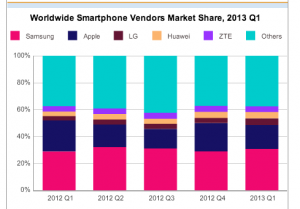Fun with percentages
This week there was a quarterly report estimating smartphone market share for different operating systems, which turned out to be packed with trapdoors for the unwary reporter. The NZ media largely avoided the problems (mostly by sensibly ignoring the report) but many international tech sites leaped in with both feet.
The basic information is in this table:
There are some important nerdy details in interpreting the numbers, such as the difference between “shipments” and “sales,” but we can ignore those for now. The main problem came in picking which numbers to report. The popular ones were the 81.0% market share for Android, the 1.5% fall in market share for Apple’s iOS, and the 156% increase in shipments for the Windows Phone.
The big rise in Windows phones is due (as the report points out) to the fact that there were basically no Windows phones being sold last year, and that’s now increased to some Windows phones being sold — not only is Windows still well behind iOS and Android, but its increase in actual phones shipped was smaller than the increase for either iOS or Android. That’s all clear just from the numbers in the report.
Android has obviously been really successful, but 80% market share doesn’t mean quite as much as it sounds: this is just one quarter of phone shipments, and nowhere near 80% of the smartphones already out there are Android — the installed base is still much larger for iOS. If you’re writing the next Candy Crush or Angry Birds, what you care about most is the number of potential customers on each operating system. On the other hand, if you’re interested in current cash flow, so that one quarter’s shipments are relevant, you care about revenue or profit, which are lower per phone for Android (which is why I now have an Android phone).
And, finally, if you’re a tech writer, as Kit Eaton points out, you should know enough about the industry to realise that Apple made a much-anticipated announcement of two new iPhone models at the end of September. Given a choice, many people (and not just psychotic Apple fanboys) would want to wait until the new phones appeared, either to buy one or to get discounted obsolete model. You’d expect iOS sales to be lower in the preceding quarter. This isn’t just hypothetical: the chart from the April IDC press release (we’re not digging very deep here) shows the contraction and expansion in Apple market share around the release of the previous model, the iPhone 5, last September.
On the other hand, at least the fact that last year also had a new iPhone release means that ignoring the context sort of cancels itself out.
(via @juhasaarinen)
Thomas Lumley (@tslumley) is Professor of Biostatistics at the University of Auckland. His research interests include semiparametric models, survey sampling, statistical computing, foundations of statistics, and whatever methodological problems his medical collaborators come up with. He also blogs at Biased and Inefficient See all posts by Thomas Lumley »

